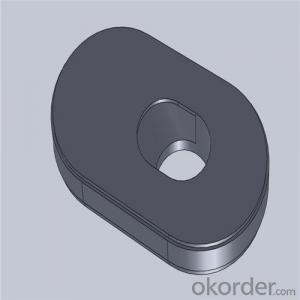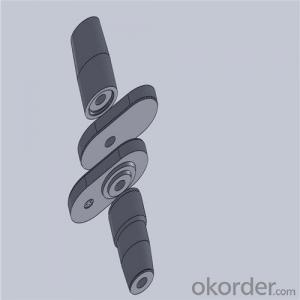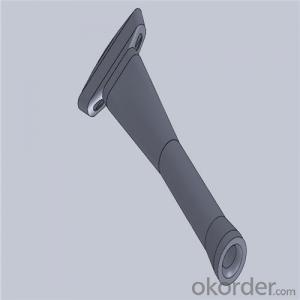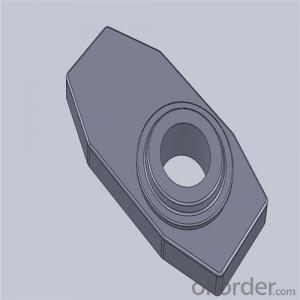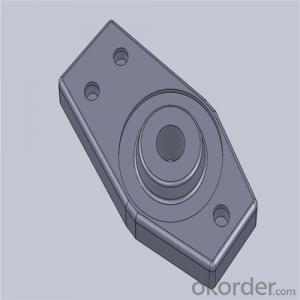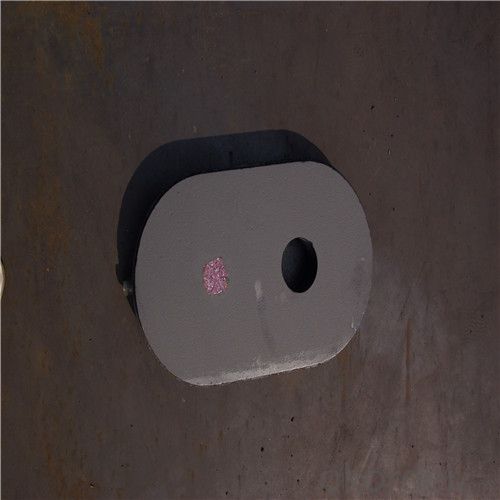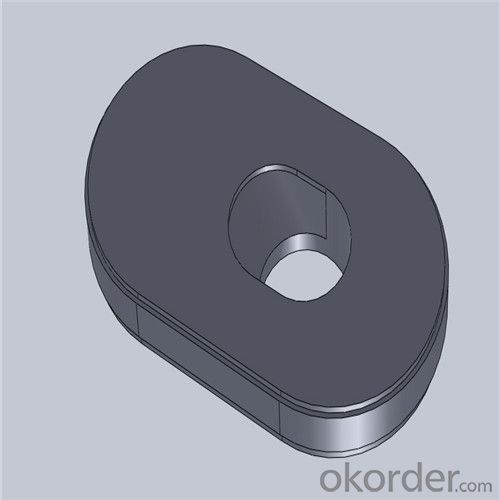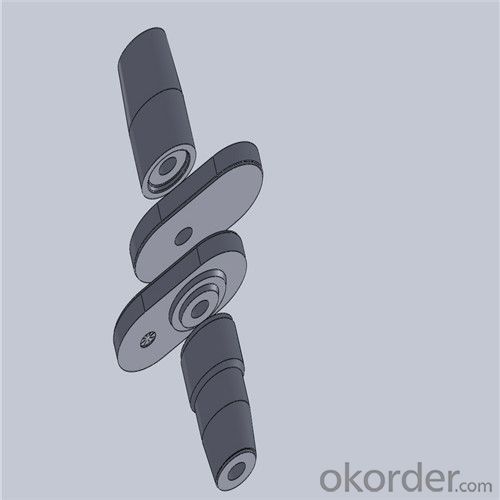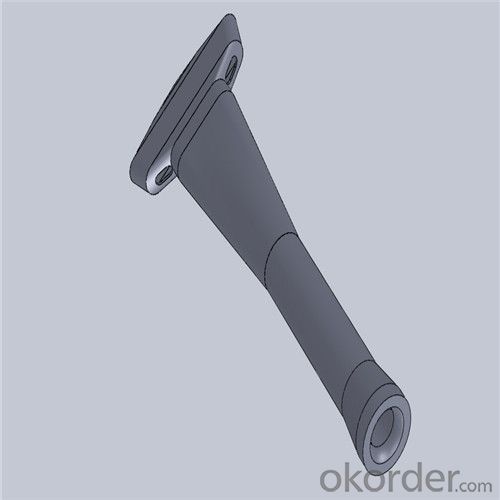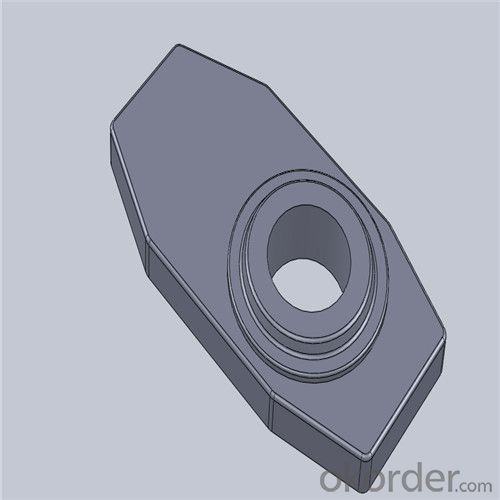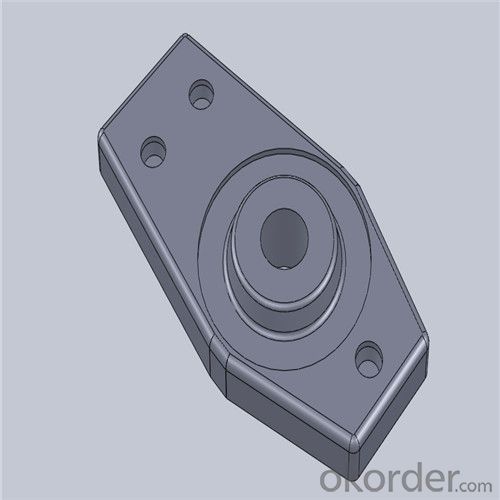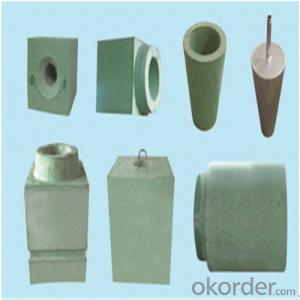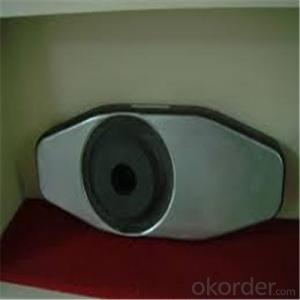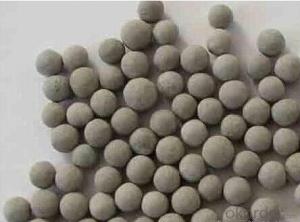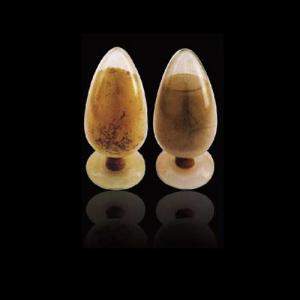Monolithic Refractories for High Performance & Temperature Ladle Sliding Gate in Steel Industry
- Loading Port:
- Shanghai
- Payment Terms:
- TT OR LC
- Min Order Qty:
- 100 pc
- Supply Capability:
- 1000 pc/month
OKorder Service Pledge
OKorder Financial Service
You Might Also Like
Quick Details for High Performance Refractory Ladle Slide Gate
| Place of Origin: | China (Mainland) | Shape: | Plate | Material: | Alumina Block |
| SiO2 Content (%): | N/A | Al2O3 Content (%): | 80-90% | MgO Content (%): | N/A |
| CaO Content (%): | N/A | Refractoriness (Degree): | 1770°< Refractoriness< 2000° | CrO Content (%): | N/A |
| SiC Content (%): | N/A | Model Number: | CS80 | Brand Name: | |
| Product name: | High performance refractory ladle slide gate | Model No.: | cs80 | Brand name: | CMAX |
| Quality: | Al-C or Al-Zr-C | Service life: | 4-6 heats | Apparent porosity: | 7% Max |
| Bulk density:: | 3.1 MIN | C.C.S: | 120MPA | MOQ: | 100 pcs for trial |
| Delivery time: | 60 working days upon receipt of deposit |
Packaging & Delivery
| Packaging Details: | Inner carton packing, outer wooden case suitable for long term sea shipping |
| Delivery Detail: | three months working days upon receipt of deposit |
Specifications
Surface flatness less than 0.05mm
High mechanical strength
Erosion resistance
Oxidation resistance
Thermal shock stability
Slide gate plate widely including Alumina carbon and Alumina Zirconia Carbon slide gate plate, MgO and MgO-spinel slide gate plate,nonoxides bonding slide gate plateand unburned slide gate plate.
General Chemical Analysis for refractory ladle slide gate :
Alumina -Zirconia-Carbon material
| Al-Zr-C Material | |||||
| Al2O3 | C | ZrO2 | Apparent porosity | Bulk density | C.C.S |
| (% minm) | (% minm) | (% minm) | (% max) | (gm./cc minm) | (MPa minm) |
| 85 | 3 | 5 | 7 | 3.1 | 120 |
| 85 | 3 | 4 | 7 | 3.1 | 120 |
Composite type: Al-Zr-C for working line, outer Al-C material
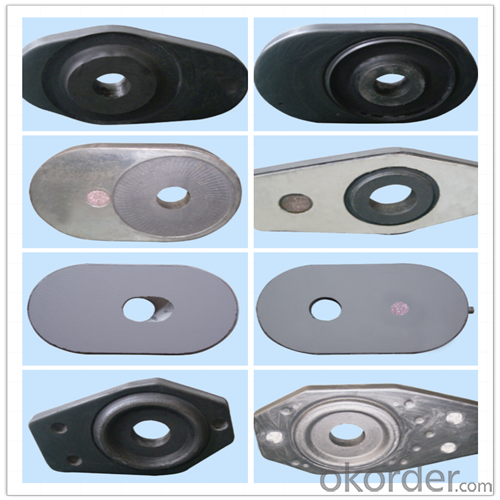
| Al-Zr-C & Al-C Material | ||||||
| Al2O3 | C | ZrO2 | Apparent porosity | Bulk density | C.C.S | |
| (% minm) | (% minm) | (% minm) | (% max) | (gm./cc minm) | (MPa minm) | |
| Inner side (Working face) | 85 | 3 | 4 | 7 | 3.1 | 120 |
| Outside | 90 | 3 | 0 | 9 | 3 | |
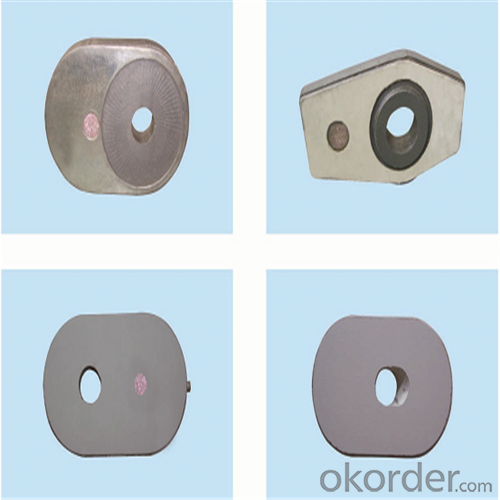
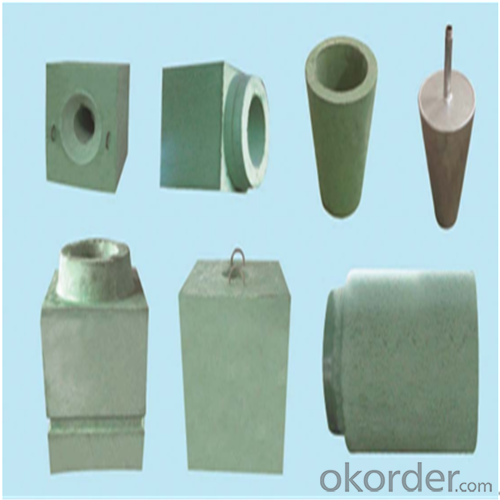
About us
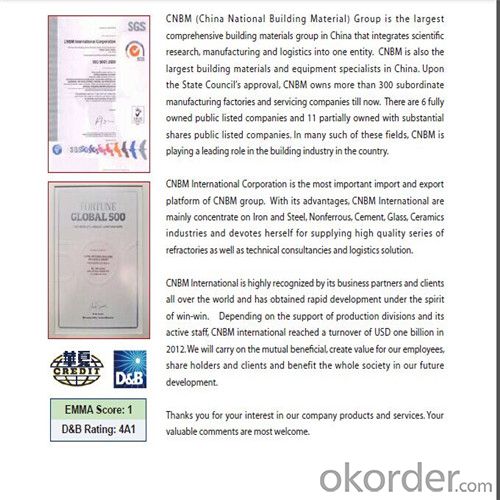
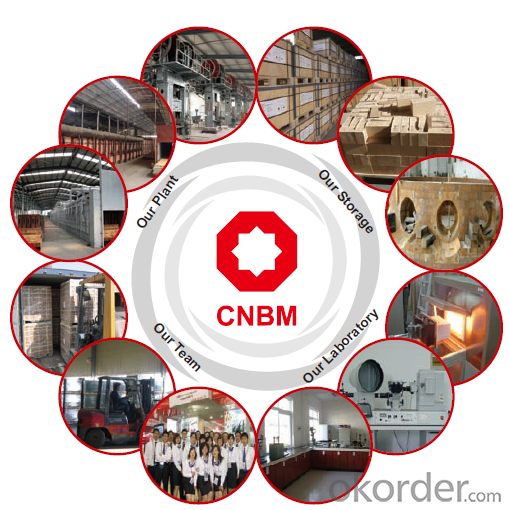
Sample is on your request.
Welcome to visit our factory~
- Q: What are the key trends in the use of monolithic refractories in the iron and steel industry?
- There are several key trends in the use of monolithic refractories in the iron and steel industry that are worth noting. Firstly, there is a growing demand for monolithic refractories due to their superior performance characteristics compared to traditional brick refractories. Monolithic refractories offer higher thermal shock resistance, better insulation properties, and improved resistance to chemical attacks. This has led to their increased usage in various applications within the iron and steel industry. Secondly, there is a shift towards the use of low-cement and ultra-low cement castables in monolithic refractories. These materials have a reduced cement content, resulting in improved refractory properties such as higher strength, better corrosion resistance, and increased resistance to thermal spalling. This trend is driven by the need to enhance the overall efficiency and durability of refractory linings in iron and steel manufacturing processes. Another important trend is the development of advanced monolithic refractories with enhanced sustainability and environmental performance. The iron and steel industry is under increasing pressure to reduce its carbon footprint and minimize environmental impact. As a result, there is a growing emphasis on the use of environmentally friendly binders and additives in monolithic refractories. These new materials not only offer excellent refractory properties but also contribute to the industry's sustainability goals. Furthermore, there is a rising focus on the development of monolithic refractories that can withstand extreme operating conditions. Iron and steel manufacturing processes involve high temperatures, aggressive chemical environments, and severe mechanical stresses. Therefore, there is a need for monolithic refractories that can endure these harsh conditions without compromising their performance. The industry is investing in research and development to create refractories that provide exceptional resistance to thermal shock, abrasion, and erosion. Lastly, there is an increasing adoption of digital and smart technologies in the monitoring and maintenance of monolithic refractories. With the advancements in sensor technology and data analytics, it is now possible to collect real-time data on the condition and performance of refractory linings. This allows for proactive maintenance, early detection of potential issues, and optimization of refractory usage, resulting in improved operational efficiency and cost savings. In conclusion, the key trends in the use of monolithic refractories in the iron and steel industry include the demand for superior performance, the shift towards low-cement and ultra-low cement castables, the development of sustainable materials, the focus on extreme operating conditions, and the adoption of digital and smart technologies for monitoring and maintenance. These trends reflect the industry's continuous efforts to enhance the efficiency, durability, and environmental sustainability of refractory linings in iron and steel manufacturing processes.
- Q: How do monolithic refractories improve the efficiency of reheating furnaces in steel plants?
- Monolithic refractories play a crucial role in improving the efficiency of reheating furnaces in steel plants. These refractories are specially designed to withstand high temperatures and harsh operating conditions, making them ideal for use in steel plants. One of the key ways in which monolithic refractories enhance furnace efficiency is by reducing heat loss. These refractories have excellent insulation properties, which help to minimize heat transfer from the furnace to its surroundings. As a result, less energy is wasted, and the furnace can maintain its desired temperature more efficiently. Additionally, monolithic refractories contribute to a more uniform and controlled heat distribution within the furnace. They can be easily shaped and installed to create a seamless lining, ensuring that heat is evenly distributed throughout the furnace chamber. This uniform heat distribution prevents hotspots and cold spots, leading to a more efficient heating process. Monolithic refractories also play a crucial role in minimizing downtime and maintenance requirements. Unlike traditional brick linings, which are prone to cracking and erosion, monolithic refractories offer superior resistance to wear and tear. This enhanced durability reduces the need for frequent repairs and replacements, allowing for uninterrupted furnace operation and increased overall efficiency. Furthermore, monolithic refractories contribute to improved energy efficiency by reducing fuel consumption. The superior insulation properties of these refractories help to retain heat within the furnace, reducing the amount of energy required to maintain the desired temperature. This leads to significant energy savings for steel plants, as less fuel is needed to achieve the same heating results. In conclusion, monolithic refractories significantly improve the efficiency of reheating furnaces in steel plants by reducing heat loss, ensuring uniform heat distribution, minimizing downtime and maintenance, and reducing fuel consumption. By incorporating these refractories into their furnace linings, steel plants can enhance their productivity, reduce energy costs, and improve the overall efficiency of their operations.
- Q: How do monolithic refractories withstand the chemical attacks in aluminum furnace applications?
- Monolithic refractories withstand chemical attacks in aluminum furnace applications due to their high resistance to oxidation and corrosion. They are specifically designed to withstand the harsh environment of aluminum processing, which involves exposure to molten aluminum, alkaline fluxes, and other corrosive chemicals. Monolithic refractories have excellent chemical stability, low porosity, and high thermal shock resistance, which allows them to maintain their structural integrity and protect the furnace lining from chemical erosion. Additionally, these refractories often contain additives such as antioxidants and anti-corrosion agents that further enhance their resistance to chemical attacks in aluminum furnace applications.
- Q: How do monolithic refractories perform in rotary hearth furnace applications?
- Monolithic refractories are known for their excellent performance in rotary hearth furnace applications. These refractories are designed to withstand the extreme temperatures and harsh conditions found in rotary hearth furnaces, making them an ideal choice for this specific application. One of the main advantages of monolithic refractories is their ability to resist thermal shock. In a rotary hearth furnace, the material being processed is subjected to rapid heating and cooling cycles, which can cause significant thermal stress on the refractory lining. Monolithic refractories have high thermal conductivity and low thermal expansion, allowing them to withstand these temperature fluctuations without cracking or spalling. Another key characteristic of monolithic refractories is their excellent abrasion resistance. In a rotary hearth furnace, the material being processed can contain abrasive particles that can erode the refractory lining over time. Monolithic refractories are formulated with high-quality aggregates and binders that offer superior resistance to abrasion, ensuring a longer service life for the lining. Furthermore, monolithic refractories have good chemical resistance, making them suitable for a wide range of applications in rotary hearth furnaces. They can withstand exposure to various chemical substances, such as molten metals, slags, and gases, without undergoing significant chemical reactions or degradation. This chemical stability ensures that the refractory lining remains intact and maintains its performance in the demanding environment of a rotary hearth furnace. Additionally, monolithic refractories offer excellent installation flexibility. Unlike traditional brick or tile refractories, which require complex installation procedures, monolithic refractories can be easily shaped and applied in-situ using various methods, such as gunning, casting, or ramming. This flexibility allows for quicker and more efficient lining repairs or replacements, reducing downtime and maintenance costs. In conclusion, monolithic refractories are highly reliable and efficient in rotary hearth furnace applications. Their ability to resist thermal shock, abrasion, and chemical attack, coupled with their easy installation, make them the preferred choice for lining materials in these demanding environments.
- Q: What are the main causes of monolithic refractory failure in the iron and steel industry?
- The main causes of monolithic refractory failure in the iron and steel industry include thermal cycling, chemical attack, mechanical wear, and improper installation or curing.
- Q: How do monolithic refractories perform in high-temperature environments?
- Monolithic refractories are highly effective in high-temperature environments due to their unique characteristics. These refractories are made from a single, continuous composition, as opposed to being composed of multiple bricks or tiles. This monolithic structure provides several advantages when it comes to performance in high-temperature conditions. Firstly, monolithic refractories have excellent thermal shock resistance. This means that they can withstand rapid temperature changes without cracking or spalling. High temperatures can cause significant stress on materials, but the monolithic structure allows for better expansion and contraction, reducing the risk of damage. Additionally, monolithic refractories have high resistance to chemical attack. In high-temperature environments, there are often aggressive chemical agents present that can corrode and erode traditional refractory materials. However, the monolithic composition is usually designed to be chemically inert, providing a protective barrier against these corrosive elements. Moreover, monolithic refractories offer superior strength and durability at high temperatures. Their single composition ensures a dense and compact structure, making them less prone to cracking or breaking under extreme thermal conditions. This strength allows them to maintain their integrity and performance even in the most demanding environments. Furthermore, monolithic refractories can be easily installed and repaired. Unlike traditional refractories, which require precise brick or tile placement, monolithic materials can be poured or sprayed into place, conforming to any shape or size. This flexibility makes installation faster and more cost-effective, reducing downtime and maintenance costs. Overall, monolithic refractories excel in high-temperature environments due to their thermal shock resistance, chemical inertness, durability, and ease of installation. Their ability to withstand extreme heat and harsh conditions makes them a preferred choice for industries such as steel, cement, glass, and petrochemicals, where high temperatures are common.
- Q: How do monolithic refractories perform in electric arc furnace roof applications?
- Monolithic refractories perform well in electric arc furnace roof applications due to their excellent thermal shock resistance, high temperature stability, and superior corrosion resistance. Additionally, monolithic refractories offer easy installation and maintenance, making them a reliable choice for electric arc furnace roofs.
- Q: How do monolithic refractories help in improving the quality of iron and steel products?
- Monolithic refractories play a crucial role in improving the quality of iron and steel products in several ways. Firstly, these refractories are used to line the furnaces and other high-temperature equipment in the iron and steel industry. By providing a high level of thermal insulation, monolithic refractories help maintain a consistent and controlled temperature inside the furnace, ensuring efficient heating and melting of metals. The use of monolithic refractories also helps in reducing heat loss, thereby increasing the energy efficiency of the process. This not only saves costs but also minimizes the environmental impact associated with high energy consumption. Additionally, the insulation properties of monolithic refractories contribute to the reduction of thermal stresses within the furnace, preventing cracks and other structural damages that can affect the quality of the iron and steel products. Moreover, monolithic refractories possess excellent resistance to chemical reactions, corrosion, and erosion caused by molten metals, slag, and other harsh substances. This resistance helps to maintain the integrity of the refractory lining, preventing contamination of the iron and steel products by unwanted impurities. As a result, the quality of the final products, such as steel bars, sheets, or pipes, is improved, meeting the desired specifications and industry standards. Another advantage of monolithic refractories is their ability to provide a smooth and clean lining surface. This smoothness minimizes the adherence of slag, molten metal, and other by-products, reducing the risk of defects and ensuring a higher-quality finish for the iron and steel products. The clean lining surface also facilitates easy maintenance and cleaning, allowing for efficient and effective operations. In summary, monolithic refractories contribute significantly to the improvement of iron and steel product quality through their exceptional thermal insulation, resistance to chemical reactions, erosion, and corrosion, as well as their ability to provide a smooth and clean lining surface. By ensuring consistent temperatures, reducing heat loss, preventing structural damages, and maintaining a clean environment, monolithic refractories enhance the overall efficiency and integrity of the iron and steel production process, resulting in high-quality end products.
- Q: How do monolithic refractories improve the performance of ladles and tundishes?
- The performance of ladles and tundishes is significantly improved by monolithic refractories in various ways. Firstly, these vessels are thermally insulated by monolithic refractories, which act as a barrier against heat loss and help maintain the desired temperature. This insulation reduces energy consumption and minimizes heat loss. Secondly, monolithic refractories offer excellent resistance to chemical corrosion and erosion. When ladles and tundishes come into contact with molten metal and fluxes, they can be severely corroded and eroded. However, the use of monolithic refractories protects against chemical attacks and extends the lifespan of these vessels. This saves costs associated with frequent repairs or replacements and ensures their integrity and safety. Furthermore, monolithic refractories provide superior mechanical strength and structural stability. Ladles and tundishes must withstand the weight of molten metal and the stresses caused during pouring and handling. With high mechanical strength, monolithic refractories can withstand these loads, maintaining their shape and integrity. This reduces downtime and increases productivity in the steelmaking process. Moreover, monolithic refractories offer flexibility in design and installation. They can be shaped and applied in various configurations, allowing customization to meet the specific requirements of ladles and tundishes. This flexibility ensures a better fit and improves the overall efficiency of the refractories, ultimately enhancing the performance of the vessels. In conclusion, monolithic refractories enhance the performance of ladles and tundishes by providing improved thermal insulation, resistance to chemical corrosion and erosion, increased mechanical strength, and flexibility in design and installation. These benefits contribute to the longevity, efficiency, and cost-effectiveness of ladles and tundishes in steelmaking operations.
- Q: How do monolithic refractories contribute to reducing downtime in iron and steel plants?
- The use of monolithic refractories plays a vital role in minimizing downtime in iron and steel plants. They have several key advantages over traditional brick refractories. To begin with, monolithic refractories are highly adaptable and can be easily shaped and installed. This allows for faster repairs and replacements. In contrast to brick refractories, which require time-consuming and labor-intensive processes like bricklaying and mortar application, monolithic materials can be directly applied in a castable or gunning form. This significantly reduces the time needed for repairs. Furthermore, monolithic refractories offer better thermal insulation and resistance to thermal shocks, which are common in iron and steel plants. This improved thermal performance helps to maintain stable operating temperatures and prevents sudden temperature fluctuations that can lead to refractory failure and subsequent downtime. By minimizing these thermal shocks, monolithic refractories increase the overall lifespan of the refractory lining, reducing the need for frequent repairs. Moreover, monolithic refractories provide superior chemical resistance compared to traditional brick refractories. Iron and steel plants often face aggressive chemical environments due to the presence of molten metal, slag, and other corrosive substances. Monolithic refractories are specifically designed to withstand these harsh conditions, preventing chemical attacks and erosion of the refractory lining. As a result, the occurrence of unscheduled shutdowns due to refractory degradation is significantly reduced. Lastly, monolithic refractories offer better dimensional stability, minimizing the risk of cracks and spalling caused by thermal cycling and mechanical stress. This increased resistance to wear and tear ensures that the refractory lining remains intact for a longer period, reducing the frequency of maintenance and enhancing the overall operational efficiency of the iron and steel plant. In conclusion, monolithic refractories contribute to downtime reduction in iron and steel plants by providing faster installation, improved thermal insulation, superior chemical resistance, and enhanced dimensional stability. Their versatility and performance advantages make them a reliable choice for maintaining an efficient and dependable refractory lining, ultimately reducing the frequency and duration of plant shutdowns.
Send your message to us
Monolithic Refractories for High Performance & Temperature Ladle Sliding Gate in Steel Industry
- Loading Port:
- Shanghai
- Payment Terms:
- TT OR LC
- Min Order Qty:
- 100 pc
- Supply Capability:
- 1000 pc/month
OKorder Service Pledge
OKorder Financial Service
Similar products
Hot products
Hot Searches
Related keywords

